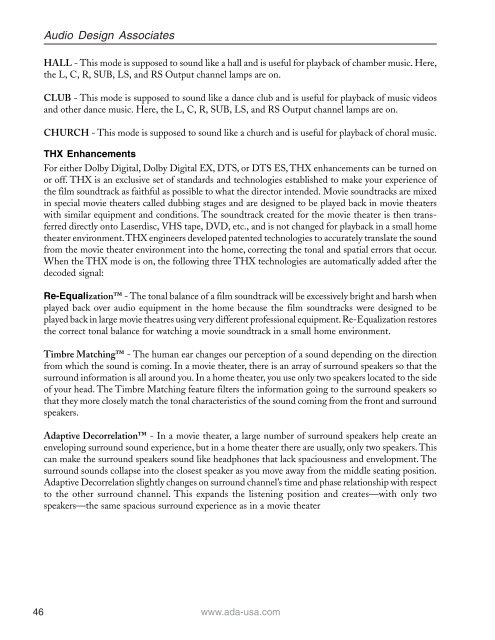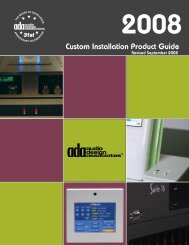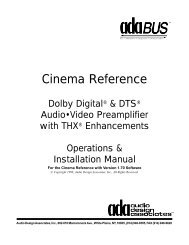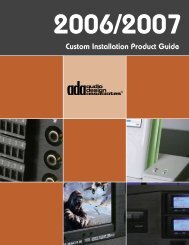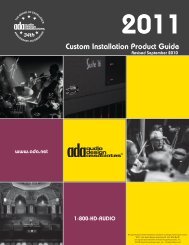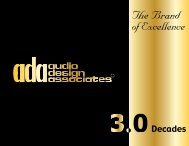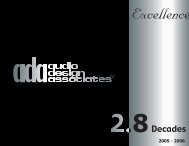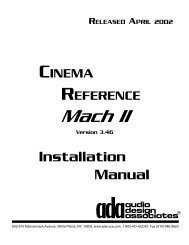Suite 7.1 Manual - Audio Design Associates
Suite 7.1 Manual - Audio Design Associates
Suite 7.1 Manual - Audio Design Associates
You also want an ePaper? Increase the reach of your titles
YUMPU automatically turns print PDFs into web optimized ePapers that Google loves.
46<br />
<strong>Audio</strong> <strong>Design</strong> <strong>Associates</strong><br />
HALL - This mode is supposed to sound like a hall and is useful for playback of chamber music. Here,<br />
the L, C, R, SUB, LS, and RS Output channel lamps are on.<br />
CLUB - This mode is supposed to sound like a dance club and is useful for playback of music videos<br />
and other dance music. Here, the L, C, R, SUB, LS, and RS Output channel lamps are on.<br />
CHURCH - This mode is supposed to sound like a church and is useful for playback of choral music.<br />
THX Enhancements<br />
For either Dolby Digital, Dolby Digital EX, DTS, or DTS ES, THX enhancements can be turned on<br />
or off. THX is an exclusive set of standards and technologies established to make your experience of<br />
the film soundtrack as faithful as possible to what the director intended. Movie soundtracks are mixed<br />
in special movie theaters called dubbing stages and are designed to be played back in movie theaters<br />
with similar equipment and conditions. The soundtrack created for the movie theater is then transferred<br />
directly onto Laserdisc, VHS tape, DVD, etc., and is not changed for playback in a small home<br />
theater environment. THX engineers developed patented technologies to accurately translate the sound<br />
from the movie theater environment into the home, correcting the tonal and spatial errors that occur.<br />
When the THX mode is on, the following three THX technologies are automatically added after the<br />
decoded signal:<br />
Re-Equalization - The tonal balance of a film soundtrack will be excessively bright and harsh when<br />
played back over audio equipment in the home because the film soundtracks were designed to be<br />
played back in large movie theatres using very different professional equipment. Re-Equalization restores<br />
the correct tonal balance for watching a movie soundtrack in a small home environment.<br />
Timbre Matching - The human ear changes our perception of a sound depending on the direction<br />
from which the sound is coming. In a movie theater, there is an array of surround speakers so that the<br />
surround information is all around you. In a home theater, you use only two speakers located to the side<br />
of your head. The Timbre Matching feature filters the information going to the surround speakers so<br />
that they more closely match the tonal characteristics of the sound coming from the front and surround<br />
speakers.<br />
Adaptive Decorrelation - In a movie theater, a large number of surround speakers help create an<br />
enveloping surround sound experience, but in a home theater there are usually, only two speakers. This<br />
can make the surround speakers sound like headphones that lack spaciousness and envelopment. The<br />
surround sounds collapse into the closest speaker as you move away from the middle seating position.<br />
Adaptive Decorrelation slightly changes on surround channel’s time and phase relationship with respect<br />
to the other surround channel. This expands the listening position and creates—with only two<br />
speakers—the same spacious surround experience as in a movie theater<br />
www.ada-usa.com


